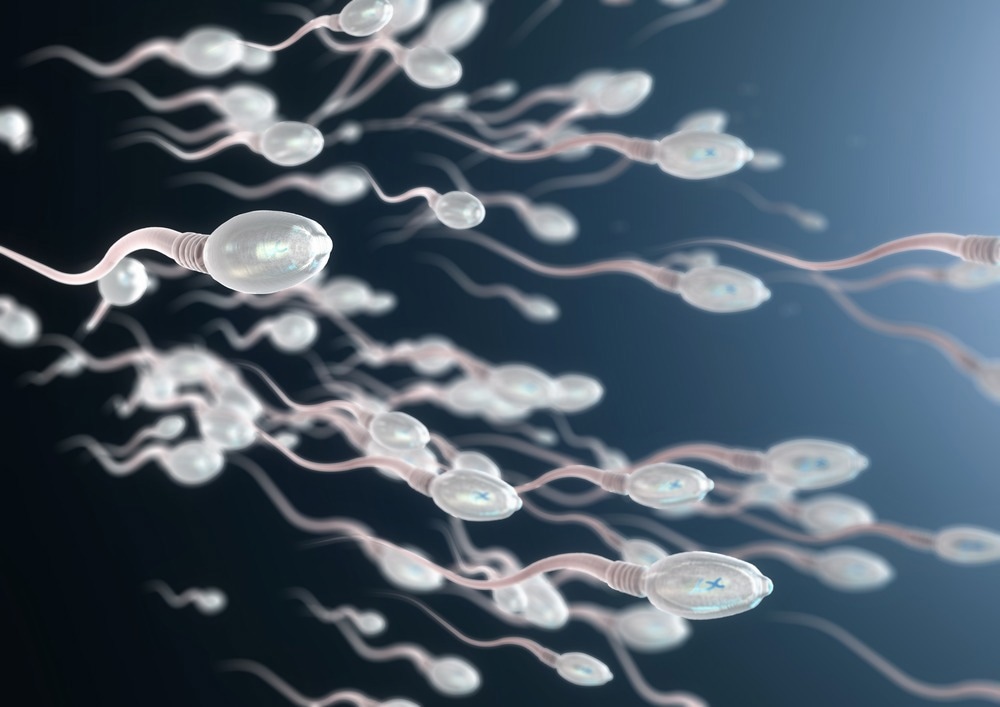Several studies have shown that severe acute respiratory syndrome coronavirus 2 (SARS-CoV-2) primarily targets the respiratory tract and later affects multiple organs. Mechanistically, the spike protein of the virus binds to the angiotensin converting enzyme 2 (ACE2) receptor of the host to establish infection.
 Study: Deleterious impact of COVID-19 pandemic: Male fertility was not out of the bag. Image Credit: Christoph Burgstedt/Shutterstock.com
Study: Deleterious impact of COVID-19 pandemic: Male fertility was not out of the bag. Image Credit: Christoph Burgstedt/Shutterstock.com
Since the ACE2 receptor is prominently expressed in several cell types in the testes, scientists ponder whether the virus impairs the semen quality of the SARS-CoV-2 infected persons, particularly among the infertile.
Background
According to the World Health Organization (WHO), individuals who are not able to conceive after 12 months of unprotected sexual intercourse can be classified as infertile. Infertile individuals undergo significant familial and social pressure that lowers their self-esteem. No scientific evidence is available regarding the sexual transmission of the SARS-CoV-2 virus or its impact on infertile couples. There is a possibility that SARS-CoV-2 infection could impact infertile couples by affecting the quality of gametes.
About the study
A recent PLoS ONE study considered the aforementioned gap in research and investigated how SARS-CoV-2 infection affected the semen quality of infertile men in Tunisia.
The coronavirus disease 2019 (COVID-19) pandemic impacted all 24 governorates of Tunisia. The current study was conducted in the Laboratory of Cytogenetics and Reproductive Biology of Monastir. Male patients who were recommended for sperm analysis during the first and second pandemic waves in Tunisia were considered in this study. All the recruited participants had a spermogram conducted before the pandemic period.
Two-time points, i.e., T1 (before the COVID-19 pandemic) and T2 (during the COVID-19 pandemic), were considered in this study. Participants under antivirals, antibiotics, anti-inflammatories, and antioxidants, between the two compared spermograms, were excluded from the cohort. In addition, participants with a history of urogenital surgery during the study period were excluded. Semen samples were obtained from the participants after 3-5 days of sexual abstinence. Both macroscopic and microscopic examinations of the semen were carried out.
Study findings
A total of 90 patients with a mean age of 38 years were recruited in this study. Most participants lived in urban areas, whose ages ranged between 30 and 39 years. Notably, this study found an impairment in sperm quality during the pandemic. Two of the key sperm parameters, i.e., sperm mortality and morphology, were found to be altered during the study period.
Around 48% of the participants were involved with a profession that could potentially compromise fertility. In addition, more than half of the study cohort consumed tobacco and were obese. Male infertility factors were identified in around 66% of the participants. Alterations in many semen parameters were found even during pre-pandemic sample analysis. These findings were consistent with previous studies that revealed sociodemographic and lifestyle factors were associated with male reproductive health.
Around 78% of the participants showed altered sperm morphology and 89% exhibited changed Multiple Abnormalities Index (MAI), i.e., the numbers were much below the WHO threshold. The two main modified male reproductive factors during the COVID-19 pandemic were sperm motility and morphology. The decline in these factors was explained via two hypotheses, which were (a) patients were infected by the virus while performing the second spermogram; and (b) the COVID-19 pandemic increased the stress factors which affected the spermatogenesis course.
Previous studies showed that viral infections, such as Human Herpes Virus (HHV), Human Immunodeficiency Virus (HIV), Hepatitis B Virus (HBV), Zika, and Ebola, influence sperm count, semen volume, motility, and morphology. More research is required to uncover the full impact of SARS-CoV-2 on semen parameters. Mechanistically, COVID-19 can impact male reproductive health by two pathways, (a) viral invasion into the reproductive cells; and (b) induction of inflammatory response in the reproductive tract due to COVID-19.
A high level of ACE2 mRNA was found in patients in their thirties, while the lowest was found in sixty-year-old males. This finding indicates that younger patients are at higher risk of testicular damage than older age groups. SARS-CoV-2 infection induces a cytokine storm associated with dysregulation of pro-inflammatory cytokines. Cytokine storm has been associated with higher production of alpha tumor necrosis factor (TNF-α) and interleukin-6 (IL-6), IL-7, IL-8 by macrophages, leukocytes, and T cells. These proapoptotic factors were also found during the inflammatory process in the testis.
Conclusions
The authors claim this to be the first Tunisian study to evaluate semen quality variations during the COVID-19 pandemic. Obesity, tobacco consumption, and professional exposure to a reprotoxic environment were found to have an adverse impact on semen quality. A significant reduction in sperm motility and abnormal spermatozoa were observed among infertile Tunisian patients during the pandemic, even without biological proof of SARS-COV-2 infection.